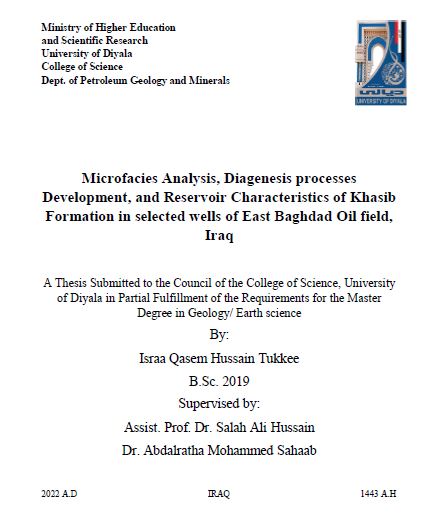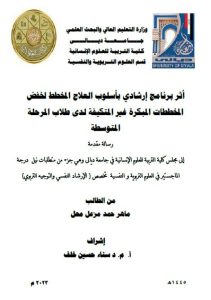اعلام المكتبة المركزية / المهندس مهند
Abstract
Khasib Formation was studied in East Baghdad oilfield, Al-Rashdiya area in Baghdad Governorate. The lithology of the formation is argillaceous limestone throughout the whole sequence in all studied wells (EB-83, EB-87, EB-92 and EB-94). It is bounded from the top with Tanuma Formation and lower contact with Kifl Formation.
The petrographic study shows three main microfacies (lime mudstone, non-laminated peloidal pack-grainstone, and laminated peloidal grainstone) and two submicrofacies (homogeneous non-fossiliferous lime mudstone, bioclast lime mudstone) the study shows the abundance of non-skeletal grains. All microfacies indicate facies zone (7, 8 and 9A) which reflect the platform interior between the open marine to the restricted and evaporitic or brackish water depositional environment.
Several diagenesis processes have been distinguished that affected the texture and porosity of Khasib Formation, the most important of which were dissolution, cementation, dolomitization, compaction, micritization, and the porosity of a non-fabric selective type, hence the increased porosity.
The lower and upper boundaries of the formation were determined using sonic log and a gamma-ray log, and the formation was divided into three main rock units (Kh1, Kh2 a, Kh2 b and Kh3). The reservoir properties of the formation were also studied using different logs, and the porosity was calculated using their logs (acoustic or sonic, neutron, and density) and it became clear that the effective porosity (range: (0_ 0.322) %) is the predominant porosity in the formation.
The volume of shale is low (range: (0_0.23) %), so the lithology formation of Khasib Formation is argillaceous limestone. The study of the reservoir of water (range: (0.08_ 1) %) and hydrocarbon saturations (range: (0_ 0.88) %) showed that the formation contains varying proportions and quantities of water and hydrocarbons suspended in the wall of the grain, and hydrocarbons capable of being produced. Kh 2 unit in well (EB-83) is the best oil reservoir unit in all selected wells in terms of porosity, water saturation, diagenesis processes and microfacies analysis and well (EB-83) is the best well in terms of oil productivity.





